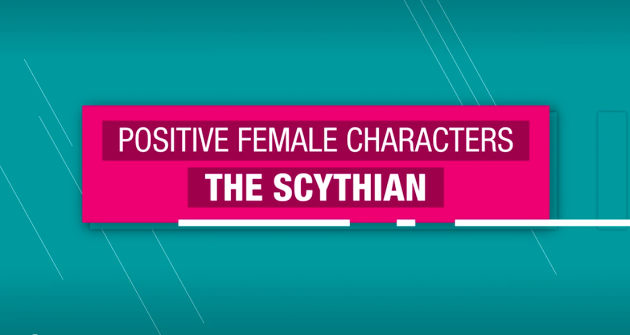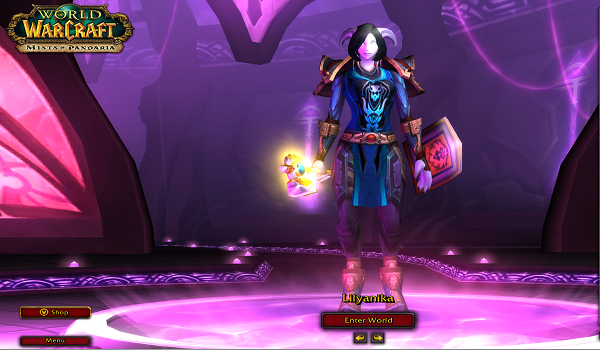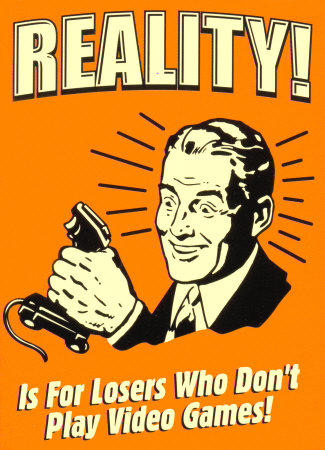The past few weeks, I’ve been writing a lot about representations of fatherhood and daughterhood, and my preoccupation with such representations stems from my interest in the ways family structures are manifested in game narratives. This week, my mind has turned from parent-child relationships and toward sibling relationships and how such familial configurations—that is, how it is the relationships between brothers and sisters—impact the ways we play games and interact with games’ narratives.
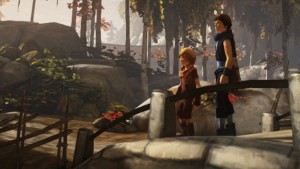 I’ve been thinking a lot about sibling relationships in games because, this week, I started playing Brothers: A Tale of Two Sons, in which two brothers, as Justin McElroy puts it, “are united by a common quest: to find a cure for their father’s mysterious ailment. Thrust out of their village and into a gorgeous storybook-reality, their only weapons are their minds, and their only resource is each other.” This relationship is highlighted through the game’s mechanics because the “player controls both brothers simultaneously, each mapped to a thumbstick.” And through this mechanical simultaneity, these two “brothers are literally sharing a brain, your brain.” While such mechanics can be tricky to get the hang of, we eventually begin to learn how to use these controls better and, at the same time, more about the brothers’ story:
I’ve been thinking a lot about sibling relationships in games because, this week, I started playing Brothers: A Tale of Two Sons, in which two brothers, as Justin McElroy puts it, “are united by a common quest: to find a cure for their father’s mysterious ailment. Thrust out of their village and into a gorgeous storybook-reality, their only weapons are their minds, and their only resource is each other.” This relationship is highlighted through the game’s mechanics because the “player controls both brothers simultaneously, each mapped to a thumbstick.” And through this mechanical simultaneity, these two “brothers are literally sharing a brain, your brain.” While such mechanics can be tricky to get the hang of, we eventually begin to learn how to use these controls better and, at the same time, more about the brothers’ story:
[A] curious thing happens as you help the siblings solve puzzles and work in concert to skirt danger. You learn. You get better at controlling these two disparate entities and, in turn, they appear to work together more seamlessly. This is not a new story, two people drawn closer by extraordinary circumstances, but what’s amazing is that this well-worn narrative is being communicated non-verbally. Little and Big don’t speak a single recognizable word in the entire game.
In other words, the game’s narrative is told through the mechanics: “Your perception of the brothers’ evolving relationship is shaped by your own brain’s ever-improving ability to control them. Put simply: It’s a story told almost entirely through game mechanics.”
These mechanics have me thinking a lot about Jasbir Puar’s discussion of assemblages, a concept she explores in Terrorist Assemblages: Homonationalism in Queer Times. Puar argues that the term assemblage “is actually an awkward translation” and comes from the French word “Agencement, a term which means design, layout, organization, arrangement, and relations—the focus being not on content but on relations, relations of patterns…[T]he priority is neither to the state of affairs (essence) nor to statement (enunciation) but rather to connection.” The English definitions of assemblage, on the other hand, “lean more to collection, combination, assembling.” As such, Puar notes, “There are thus numerous ways to define what assemblages are, but I am here more interested in what assemblages do.” And, for Puar, one of the things that assemblages do is “de-privilege the human body as a discrete organic thing…Assemblages do not privilege bodies as human, nor as residing within a human/animal binary. Along with a de-exceptionalizing of human bodies, multiple forms of matter can be bodies—bodies of water, cities, institutions, and so on. Matter is an actor.” Thus, assemblages blur the boundaries between bodies, and because matter is an actor, because assemblages are constantly in motion, “categories—race, gender, sexuality—are considered events, actions, and encounters, between bodies, rather than simply entities and attributes of subjects.” Such activity causes Puar to seek to reread intersectionality as assemblage, to reread identification not as something that is static but as “a process; identity is an encounter, an event, an accident, in fact. Identities are multi-causal, multi-directional, liminal; traces aren’t always self-evident. In this ‘becoming of intersectionality,’ there is emphasis on motion rather than gridlock; on how the halting of motion produces the demand to locate.” And by reading intersectionality as assemblage, Puar works to interrogate the “different conceptual problems posed by each”:
[I]ntersectionality attempts to comprehend political institutions and their attendant forms of social normativity and disciplinary administration, while assemblages, in an effort to re-introduce politics into the political, asks what is prior to and beyond what gets established. So it seems to me that one of the big payoffs for thinking through the intertwined relations of intersectionality and assemblages is that it can help us produce more roadmaps of precisely these not quite fully understood relations between discipline and control.
In short, by putting intersectionality and assemblage in conversation with each other, Puar contends that these two concepts “need not be oppositional, but rather frictional,” and it is through the frictional conversation between intersectionality and assemblage that we might better understand how identities are fluid, how bodies are processes, how all these things are connected and related, and how all these things are situated within systems of power and control.
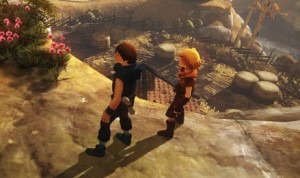 So this idea of assemblage is something I’ve been thinking about as I play Brothers and something I’ve been thinking about as I consider the implications of the game’s mechanics. I’ve been wondering if we might think of the controller, in the context of this game, as a conduit of assemblage, as the vessel through which assemblage is framed. Indeed, through the controller, the right and left thumbsticks, the right and left triggers, we move and act through the two brothers simultaneously, together. The controller, then, is a body—because “matter is an actor,” as Puar says—one that is tied to the bodies of the brothers and that is also tied to the body of the player, and through such connections all these bodies work together to act, to move through the game, to tell its story.
So this idea of assemblage is something I’ve been thinking about as I play Brothers and something I’ve been thinking about as I consider the implications of the game’s mechanics. I’ve been wondering if we might think of the controller, in the context of this game, as a conduit of assemblage, as the vessel through which assemblage is framed. Indeed, through the controller, the right and left thumbsticks, the right and left triggers, we move and act through the two brothers simultaneously, together. The controller, then, is a body—because “matter is an actor,” as Puar says—one that is tied to the bodies of the brothers and that is also tied to the body of the player, and through such connections all these bodies work together to act, to move through the game, to tell its story.
But I’m also wondering what it would mean for such mechanics, the assemblage of Brothers, to be used in service of a game about sisters. Because it seems to me that we get much more of a chance to play brothers in games than we do sisters. And if we could extend these mechanics of the assemblage to construct a relationship between sisters, I wonder—would it then be possible to enact, through games, a feminist project? To make games that tell stories about the relationships of sisters, about assemblages of women?
Such questions cause me to think now about Chandra Mohanty’s Feminism without Borders: Decolonizing Theory, Practicing Solidarity, in which she discusses sisterhood and feminist solidarity. As Malia Formes explains, Mohanty’s model of solidarity moves beyond the “idea of sisterhood, which Mohanty criticizes for assuming too much homogenity among women…Solidarity, by contrast, involves ‘mutuality, accountability, and the recognition of common interests as the basis for relationships among diverse communities.’” Feminist solidarity, then, as opposed to the homogenizing construction of sisterhood, requires a heterogeneous connectivity of experience, which “validates the multiple sources of feminist ideas, whether academic or non-academic, experiential or theoretical,” and perhaps we might also connect these multiple sources of experience and knowledge to Puar’s construction of assemblage, for we might conceive of this multiplicity of experience as (to reiterate Puar’s phrasing) “events, actions, and encounters, between bodies”—as processes that allow us to create connections, to create assemblages, not in ways that are normalizing or decontextualizing or universalizing but in ways that promote processes of intersectionality and heterogeneous solidarity.
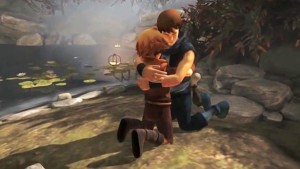 Such thoughts, once again, bring me back to thinking about brothers and sisters in video games. I know that, personally, as someone with a sister, I think it would be nice to see more sisters’ relationships depicted in games, to be able to get a chance to play and experience such relationships in a way that is not homogenizing or essentializing, and I wonder if there is a way to practice feminist solidarity through narrative constructions of sisterhood. I wonder if there is a way for games to represent the relationship between sisters in a way that makes use of intersectionality and assemblage. I wonder if mechanics like those of Brothers can (or will) be extended from exploring the relationship between brothers to exploring the relationship between sisters or to exploring the other, many, multiple ways people are connected to each other—to exploring assemblage and solidarity. I don’t know. I hope so. Because it’s fun to think about.
Such thoughts, once again, bring me back to thinking about brothers and sisters in video games. I know that, personally, as someone with a sister, I think it would be nice to see more sisters’ relationships depicted in games, to be able to get a chance to play and experience such relationships in a way that is not homogenizing or essentializing, and I wonder if there is a way to practice feminist solidarity through narrative constructions of sisterhood. I wonder if there is a way for games to represent the relationship between sisters in a way that makes use of intersectionality and assemblage. I wonder if mechanics like those of Brothers can (or will) be extended from exploring the relationship between brothers to exploring the relationship between sisters or to exploring the other, many, multiple ways people are connected to each other—to exploring assemblage and solidarity. I don’t know. I hope so. Because it’s fun to think about.

